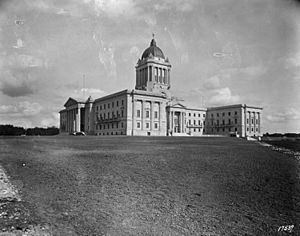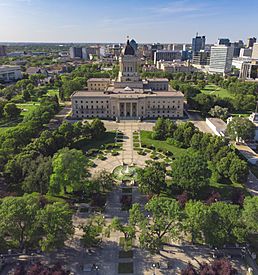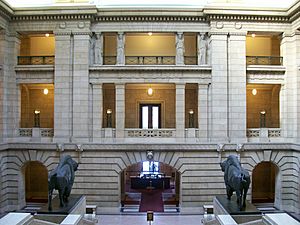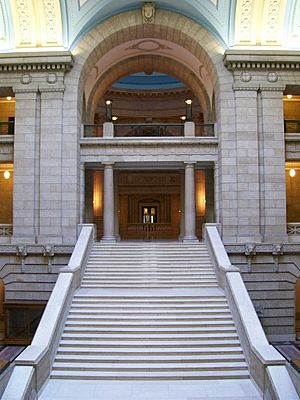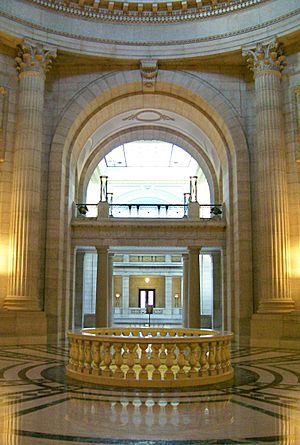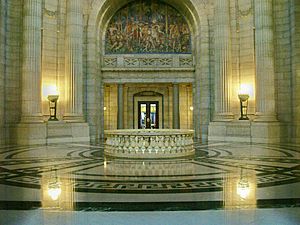Manitoba Legislative Building facts for kids
Quick facts for kids Manitoba Legislative Building |
|
|---|---|
 |
|
| General information | |
| Architectural style | Neoclassical |
| Address | 450 Broadway |
| Town or city | Winnipeg, Manitoba |
| Country | Canada |
| Construction started | 1913 |
| Opened | 15 July 1920 |
| Cost | C$8,075,865 (1921 est.) |
| Height | 242 feet (74 m) |
| Technical details | |
| Floor area | 250,000 ft2 |
| Design and construction | |
| Architect | Frank Worthington Simon & Henry Boddington III |
The Manitoba Legislative Building is a very important place in Winnipeg, Manitoba. It's where the Legislative Assembly of Manitoba meets to make laws for the province. You might also hear it called the Manitoba Parliament Building.
This amazing building is also home to the offices of Manitoba's Premier (like a provincial prime minister), the Lieutenant Governor, and other important government officials. It's a heritage site, meaning it's a special place protected for its history.
The building was finished in 1920. It has a grand style called Neoclassical and Beaux-Arts. On top of its dome, you'll see a famous gold-covered statue called the Golden Boy. This statue is based on the Roman god Mercury and stands about 77 meters (253 feet) tall!
Contents
History of the Manitoba Legislative Building
The building you see today is the third one used by Manitoba's government. The very first one was a simple log cabin that burned down in 1873. After that, temporary places were used until a second building opened in 1884.
By 1909, Manitoba was growing fast. Its population had increased a lot, and the government needed a bigger, more impressive building. They wanted a place that showed how important the province had become.
In 1911, the government held a competition for architects from the British Empire. They offered a big prize for the best design. Out of 67 ideas, the design by Frank Worthington Simon was chosen. He had studied at a famous art school in Paris.
Building the Legislature
Construction started in the summer of 1913. Workers had to dig out a lot of soil. The building's location was even shifted a bit during this time. Special Manitoba Tyndall stone was brought from a quarry near Winnipeg. On June 3, 1914, a special ceremony took place to lay the cornerstone.
Building such a huge structure took almost seven years. There were many challenges, like shortages of workers and money because of World War I. There were also labor problems during the Winnipeg general strike. The project faced issues with materials and management, which led to an investigation and changes in government leadership. Because of these problems, the building wasn't fully ready until 1919.
The famous Golden Boy statue was put in place in November 1919. The total cost of the building was about C$9.3 million.
After Construction
Even before it was fully finished, government offices and staff started moving in. The first official meeting of the Legislative Assembly in the new building happened on January 22, 1919.
In September 1919, the Prince of Wales (who would later become King Edward VIII) visited and unofficially opened the building. The grand opening ceremony took place on July 15, 1920. This date was special because it was the 50th anniversary of Manitoba joining Canada.
During the Great Depression in the 1930s, parts of the building's grounds were used for vegetable gardens to help unemployed men. In 1989, the building was officially named a Manitoba Provincial Heritage Site.
Recent Events at the Building
Over the years, the building has seen many changes and repairs. In 1994, the steps at the entrances were fixed. In 1995, the Manitoba Plaza was opened on the south grounds to celebrate the province's 125th anniversary.
The Legislative Building has even been used as a set for movies and TV shows, like Capote. The Reading Room, which is usually a library, has been turned into a courtroom for filming!
In 2002, the outer dome got new copper sheathing. By 2014, there were concerns about the building's condition due to tree roots, insects, and bird droppings. Repairing it completely would be very expensive today.
In 2012, the skylights over the Grand Staircase were replaced. In 2015, a military hall of honor opened inside, remembering Manitoban soldiers from World War I. In 2016, the building got its first gender-neutral washroom.
In 2007, Manitoba was the first province to add an accessibility ramp at its front entrance. In 2017, more changes were made to make the Legislative Chamber easier for people using wheelchairs to access. This renovation even won an award in 2018.
On January 22, 2020, the province celebrated 100 years since the first session of the Manitoba Legislature was held in the building's Chamber.
Building Materials and Size
The building is made from Tyndall stone and different types of marble. These stones contain fossils of ancient sea creatures like snails and trilobites! The largest fossil found is about 1 meter (3 feet) wide.
The building is built with a steel frame and weighs an incredible 243,851,258 kilograms (24,000 tons). You can find examples of the Fibonacci Sequence and Golden Ratio in its design, which are mathematical patterns found in nature.
The building has two domes: an outer one and an inner one that you can see from inside. There's also a secret tunnel system under Broadway Avenue that connects the Legislative Building to other government buildings for heating.
Outside the Building
The total area of the building is about 23,000 square meters (5.7 acres). The top of the building, where the Golden Boy stands, is about 74 meters (243 feet) above the ground. The Golden Boy statue is made of bronze and covered with real 23.75-karat gold leaf.
The outer dome is held up by four huge steel beams, each weighing about 98,557 kilograms (97 tons). The grounds around the building cover 120,000 square meters (30 acres) and are beautifully landscaped. The building itself sits on 421 concrete supports that go deep into the ground.
The outside steps are made from granite from Ontario. Many of the statues on the exterior are made from Bedford Limestone from Indiana.
Inside the Building
The building has a floor area of about 24,959 square meters (6.2 acres). Its basic shape looks like the letter "H" inside a rectangle.
The marble used inside also has fossils. You'll find Tennessee marble for the floors and Botticino marble from Italy for the Grand Staircase. The doors and trim are made from different kinds of wood, like birch, oak, and walnut. The building also has special clocks that are controlled by a central clock.
Exterior Design and Art
The building's design is a mix of Neoclassical styles, like Beaux-Arts. It's very grand and impressive.
The Pediment and Sphinxes
On the north side of the building, above six large columns, is the main pediment. This is a triangular section with carved figures. These figures were designed by a Scottish sculptor named Albert Hemstock Hodge.
Above the main pediment, you'll see two Egyptian sphinxes facing east and west. They have a special message carved in Egyptian hieroglyphics that says, "The everlasting manifestation of the Sun God Ra, the good God who gives life."
The carvings on the pediment tell a story about Manitoba. For example, one part shows "Enterprise" calling workers to a "Land of Promise." There's also a bull led by "Europe," symbolizing immigration. Another part shows a family, representing new settlers. Two figures embracing a jar of water represent the Red and Assiniboine Rivers joining together and making the land fertile. You can also see a farmer with his horse and figures bringing fruits from the soil. In the center is "Lady Manitoba," a goddess-like figure representing the province.
Entrances and Grounds
At the four corners of the dome's base, there are statues representing Agriculture, Art, Industry, and Learning. At the east and west entrances, you'll find statues of important historical figures like La Verendrye and Lord Selkirk on the east, and General James Wolfe and Lord Dufferin on the west.
On the east and west sides, there are figures representing war and peace. The east side shows male figures with weapons, like a native warrior and a Roman soldier. The west side has two female figures symbolizing peace. Each pair guards a chest.
In front of the building, there's a statue of Queen Victoria. On the south grounds, you'll find the Manitoba Plaza and a fountain. There's also a sculpture of Louis-Riel, a leader of the Métis people. This statue was placed there in 1996. The grounds also have six greenhouses that grow thousands of plants each year for the gardens.
The Golden Boy

The Golden Boy is one of Manitoba's most famous symbols. At each corner of the copper dome supporting him, there are stone carvings representing the four elements of alchemy: earth, air, fire, and water. These are also linked to Agriculture, Science, Industry, and Art.
The dome is about 68 meters (223 feet) above the main floor. The statue itself was first put up in 1919. It was originally called Eternal Youth and was sculpted by a Parisian artist named Georges Gardet. The Golden Boy was re-gilded with gold and cleaned up in 2002, and it's lit up by floodlights at night.
Inside the Building
The building has many empty spaces where statues were planned but never put in. You'll also see plaques on the walls that tell about Manitoba's history.
Main Entrance and Grand Staircase
The main entrance is a perfectly square room. Inside, you'll find the Grand Staircase, which is 6.1 meters (20 feet) wide. It has three sections, each with 13 steps, made from beautiful Italian marbles.
Above the Grand Staircase, there are two skylights that let natural sunlight fill the room.
Flanking the steps are two life-size bison statues. These are a symbol of Manitoba and are meant to guard the entrance, like sacred bulls in ancient temples. They are made of solid bronze and each weighs 2,268 kilograms (2.5 tons). Legend says that to get them inside without damaging the floor, the entrance was flooded and frozen. The bison were then slid in on huge blocks of ice from the Assiniboine River.
Above the south entrance, you'll see the head of Medusa. Facing Medusa, above the north entrance, is a bust of Athena, the Greek goddess of war and protector of cities. Around the room, there are 14 lion heads and 8 cattle skulls. On the second-floor balcony, lamps have 13 bulbs, with 12 around one, symbolizing the Twelve Apostles and Jesus.
On the third floor, two pairs of caryatids (columns shaped like female figures) support the area, each holding a scroll and a key.
The Rotunda
The Rotunda is a large, round room at the top of the Grand Staircase. It's 20 meters (64 feet) wide and 26 meters (84 feet) high. Inside the dome above, there are four panels with five gold rosettes each.
Between the columns in the Rotunda, you'll see busts of Hermes. The floor is made of different types of marble.
In the center of the Rotunda, there's an Italian marble railing that is 4 meters (13 feet) across. This surrounds the Pool of the Black Star on the floor below. The circle above the railing is also 4 meters wide, and both line up perfectly with the Golden Boy statue on top of the building.
Above the doorway to the Legislative Assembly, there's a large painting by Frank Brangwyn that shows scenes from World War I.
Pool of the Black Star
The Pool of the Black Star is a special circular room directly below the Rotunda. It has four entrances and three steps around its edge. In the center of the floor, there's an 8-pointed black marble star. The Golden Boy statue on the roof is directly above this star.
Because of the building's design, sounds from all over the building can be heard in this circular room. If you speak in the room, you can hear echoes. The light fixtures around the room have interesting designs, including sea creatures and heads.
Legislative Chamber
The Legislative Assembly of Manitoba meets in the Legislative Chamber to make laws. There are 57 members elected to this assembly. When Manitoba first became a province in 1870, there were only 24 members.
The light fixtures at the entrance to the Chamber also have sea creatures and heads. The Chamber doors have bison designs, but all the bison face the same way because of a casting error. Above the Chamber entrance, there's another painting by Frank Brangwyn that represents Canada's efforts in World War I.
Inside the Chamber, there are murals by Augustus Vincent Tack. These paintings show important ideas like Justice, Knowledge, Wisdom, Tolerance, and Courage.
The Speaker of the Legislative Assembly sits in a special chair on the south wall. To the right of the Speaker, there's a statue of Moses holding the Ten Commandments. To the left, there's a statue of Solon, a famous lawmaker from ancient Greece. Both statues are made of bronze.
Manitoba's Legislative Chamber is unique because the members' desks are arranged in a horseshoe shape. The desks and chairs are made of walnut wood. Each desk has a microphone connected to a sound system that records everything said for official reports. During question period, translators help by providing instant translations from French to English.
The Chamber is also set up for video and internet broadcasts of important events. Even with all these modern updates, you can still see the original inkwells used by earlier politicians!
Other Rooms and Halls
It's a fun fact that rooms on the east side of the building have odd numbers, and rooms on the west side have even numbers. This can sometimes confuse new visitors!
Lower Levels
- Basement: The basement has two large vaults. A very old and important document called the Magna Carta was once stored here.
- The Hall of Honour (first floor, east side) has the Books of Remembrance. These books list the names of Canadians who died in wars from the Boer War to the Korean War. You'll also find plaques for Manitoban military groups.
- The Keystone Gallery (lower level, west side) shows different art and heritage exhibits from Manitoba. In 2020, a time capsule was placed here. It will be opened in 2120, on the building's 200th anniversary!
Second Floor
On the second floor, you can see portraits of past Speakers of the Legislative Assembly. There are also photos of Manitoba's Premiers. The names of people who have received the Order of Manitoba are displayed on the east side hallway. The original maces (symbols of the Legislature's authority) are also on display here.
- The Manitoba Room (Room 200), also called the Chandelier Room, is used for special events. It has painted portraits of King George V and Queen Mary, and Queen Elizabeth II and Prince Philip.
- The Reading Room of the Manitoba Legislative Library (Room 260) has three levels of bookshelves and can hold 25,000 books. You can reach the upper levels by spiral staircases or the room's original elevator.
- The Trailblazers Gallery (2nd floor, west side) was opened in 2018. It honors 18 women who have achieved great things or created new paths for women in Manitoba.
See also
 In Spanish: Edificio Legislativo de Manitoba para niños
In Spanish: Edificio Legislativo de Manitoba para niños


